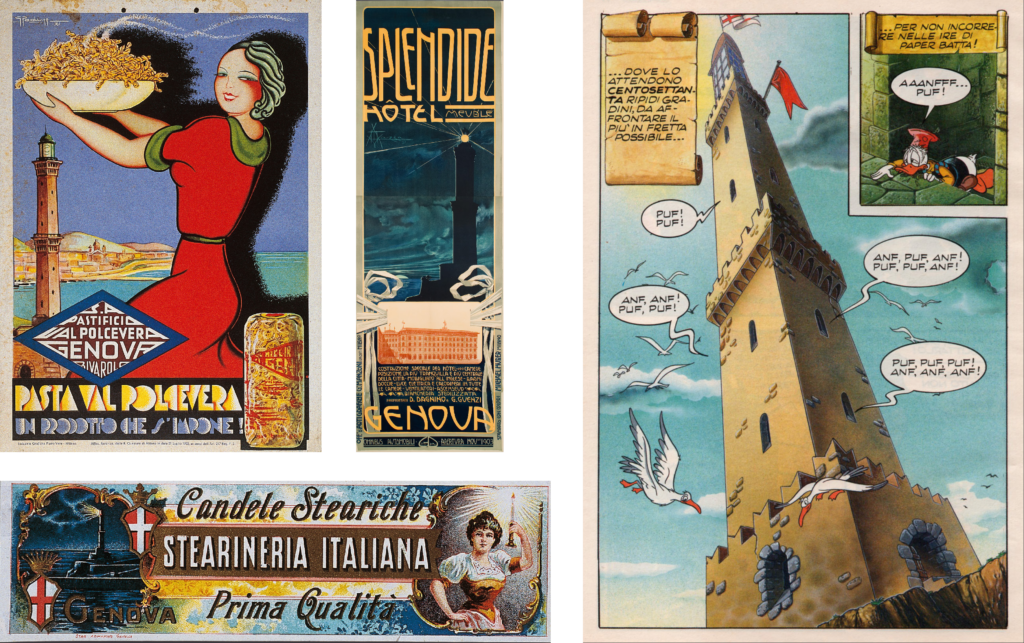La Lanterna
nell’immaginario
loghi, insegne, pubblicità e… Paperin Pestello!

La Lanterna simbolo di genovesità nella pubblicità della Pasta Val Polcevera (1933), nel manifesto dell’Hotel Splendide (1903), su un’etichetta di candele di inizio Novecento e coprotagonista con Paperino della storia “Paperin Pestello e la via delle Indie” di Sandra Verda e Giulio Chierchini, pubblicata sul TOPOLINO del 30 agosto 1992 // The Lanterna symbolizing Genoese identity in the advertisement of Pasta Val Polcevera (1933), in the poster of the Hotel Splendide (1903), on a candle label of the first decade of the 20th century; it co-stars with Donald Duck in the story “Donald Duck and the voyage to the Indies” by Sandra Verda and Giulio Chierchini (TOPOLINO, 30 August 1992)
Il faro è il simbolo della città, ma non solo
Il faro e la sua luce sono stati per secoli (e in particolare durante le grandi migrazioni otto-novecentesche verso il Nord e il Sud America) simbolo di Genova e dell’Italia tutta per chi partiva e per chi tornava, ma anche evocazione nel ricordo della vita che ci si lasciava alle spalle, della famiglia, degli amici, e delle speranze che animavano il viaggio.
È veramente straordinaria e unica l’identificazione della città e dei suoi abitanti con questa antica torre e la sua costante e indelebile presenza nell’immaginario ligure, italiano e anche europeo, in maniera ininterrotta, per secoli: nelle prime carte nautiche quattrocentesche la Lanterna era il simbolo grafico che distingueva la città dagli altri porti di notevole importanza e, nelle incisioni che illustravano volumi sul mondo allora conosciuto, Genova già era la città della Lanterna, con il faro con le due torri sovrapposte, ben riconoscibile sulla sinistra delle composizioni. Sempre protagonista e vigile anche nel Settecento, con le prime vedute ad uso propagandistico e celebrativo, spesso nei quadri che celebravano dogi e senatori della Repubblica, ma anche patrizi, diplomatici e poi sovrani.
La Lanterna si riconosce su frontespizi di libri antichi e contemporanei, su dedicatorie di messe di incoronazione, poemi, volumi a stampa dell’aristocrazia genovese. E quando i pittori volevano rappresentare la città, era il faro ad essere subito inserito come elemento chiaro e universalmente riconoscibile, che si trattasse di un’allegoria, una veduta d’invenzione o un panorama. Con l’ingresso di Genova nella modernità dell’industria e del commercio, la presenza della Lanterna è cresciuta esponenzialmente in ogni possibile mezzo di comunicazione, che si trattasse di un logo, una grafica promozionale, una pubblicità, un fumetto: la Lanterna è il simbolo identitario di “genovesità” in manifesti, confezioni, biglietti e carte intestate, azioni societarie, diplomi e riconoscimenti. Già dall’Ottocento campeggia sulle copertine di guide turistiche, cartoline, souvenir e, in epoca contemporanea, calamite ricordo. Sembrerà ridondante scriverlo, ma la Lanterna è stata e continua ad essere segno distintivo nei simboli di corporazioni e associazioni professionali, nonchè società sportive. Ed è anche così che la partita di calcio giocata dalle due squadre cittadine, Genoa e Sampdoria, è universalmente conosciuta come il “Derby della Lanterna”.
Insomma, essa è al tempo stesso simbolo identitario, totem, metafora, silhouette, segno grafico, elemento di riconoscibilità e appartenenza.
The Lighthouse in images:
logos, signs, advertising and…
Donald Duck!
The Lighthouse: a city landmark and much more
For centuries (particularly during the great 19th- and 20th-century migrations to North and South America) the lighthouse and its beacon have been a landmark for Genoa and Italy in general for all those leaving and returning; a symbol of the life left behind, of family and friends, and of the hopes underlying the journey.
The City of Genoa and its people identify themselves with this ancient tower in a truly extraordinary and unique way, and its constant and indelible presence in the Ligurian, Italian and even European imagery has continued uninterruptedly for centuries. In the first nautical charts of the 15th century, the Lanterna was the graphic symbol that distinguished the city from other important ports; in the engravings featured in the illustrated books of the world, Genoa was already the City of the Lanterna, with its two-tiered lighthouse clearly visible on the left-hand side of the composition. It was also a prominent and vigilant symbol in the 18th century, with the first landscape views made for propaganda and celebratory purposes, in paintings honouring not only Doges and Senators of the Republic, but also patricians, diplomats and, later, sovereigns.
The Lanterna can be recognised on the cover of ancient and contemporary books, on the title pages of coronation masses, in poems and in the printed texts of the Genoese aristocracy. When painters wished to depict the city, the Lighthouse was immediately featured as a clear and universally recognisable element, whether it was an allegory, an imaginary view or a landscape. When Genoa entered the modern age of industry and commerce, the presence of the Lanterna grew exponentially in all media, be it a logo, a commercial image, an advertisement or a comic strip: the Lanterna is the identifying symbol of “Genoese-ness” in posters, packaging, stationery, corporate stock, diplomas and awards. Ever since the 19th century, it has been featured on the covers of tourist guides, postcards, souvenirs and, now even in fridge magnets. As redundant as it may seem, the Lanterna has been and continues to be a distinctive symbol of guilds and professional associations, as well as sport clubs. In fact, the derby between Genoa and Sampdoria, the city’s two football clubs, is universally known as ‘Derby della Lanterna’.
Ultimately, the Lighthouse is a distinctive symbol, a totem, a metaphor, a silhouette, a graphic feature, an item of recognition and belonging.
